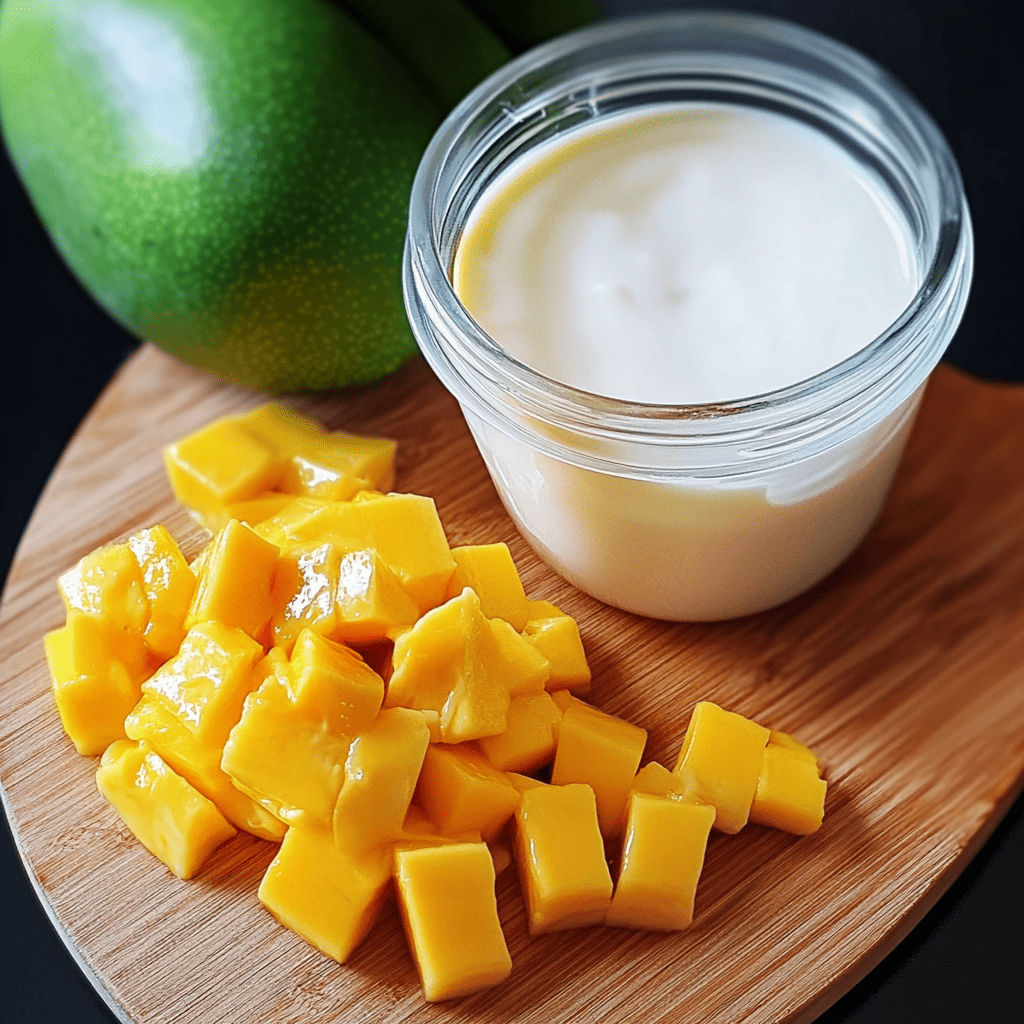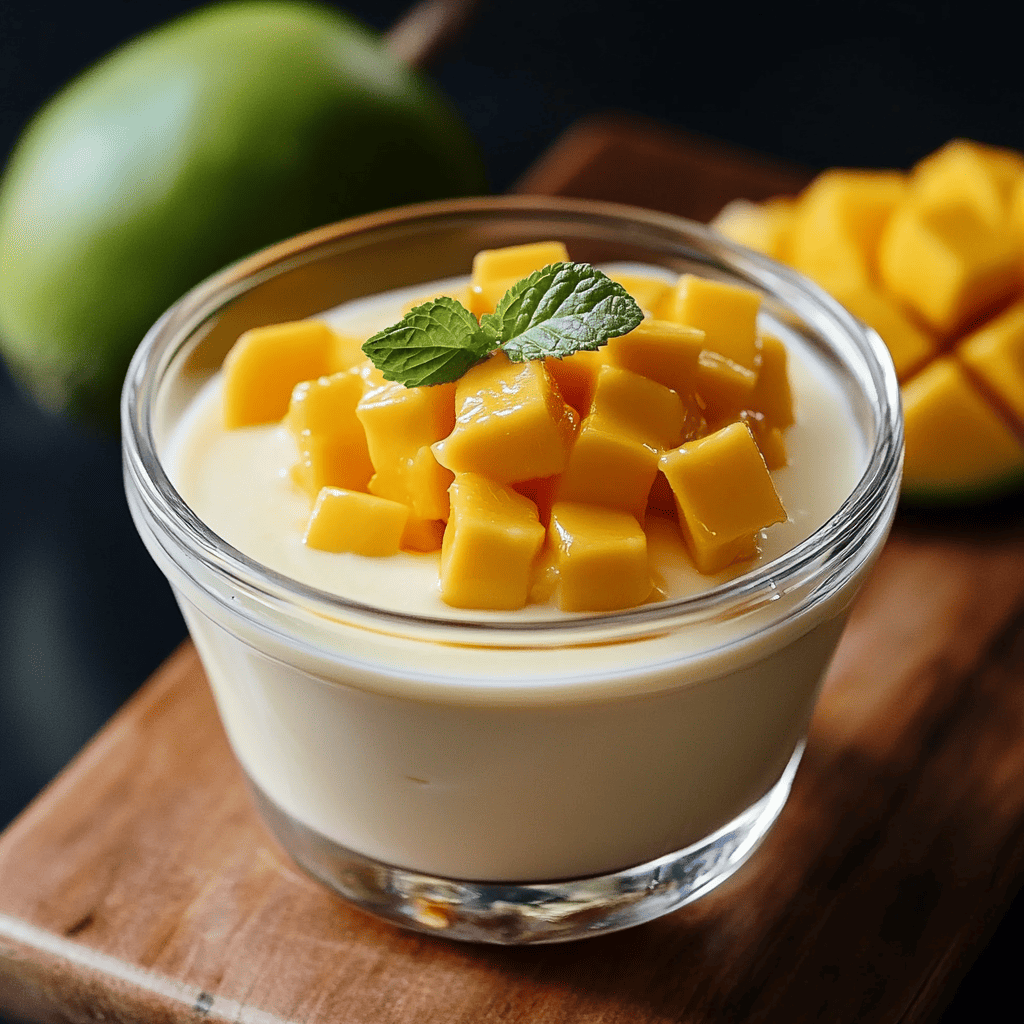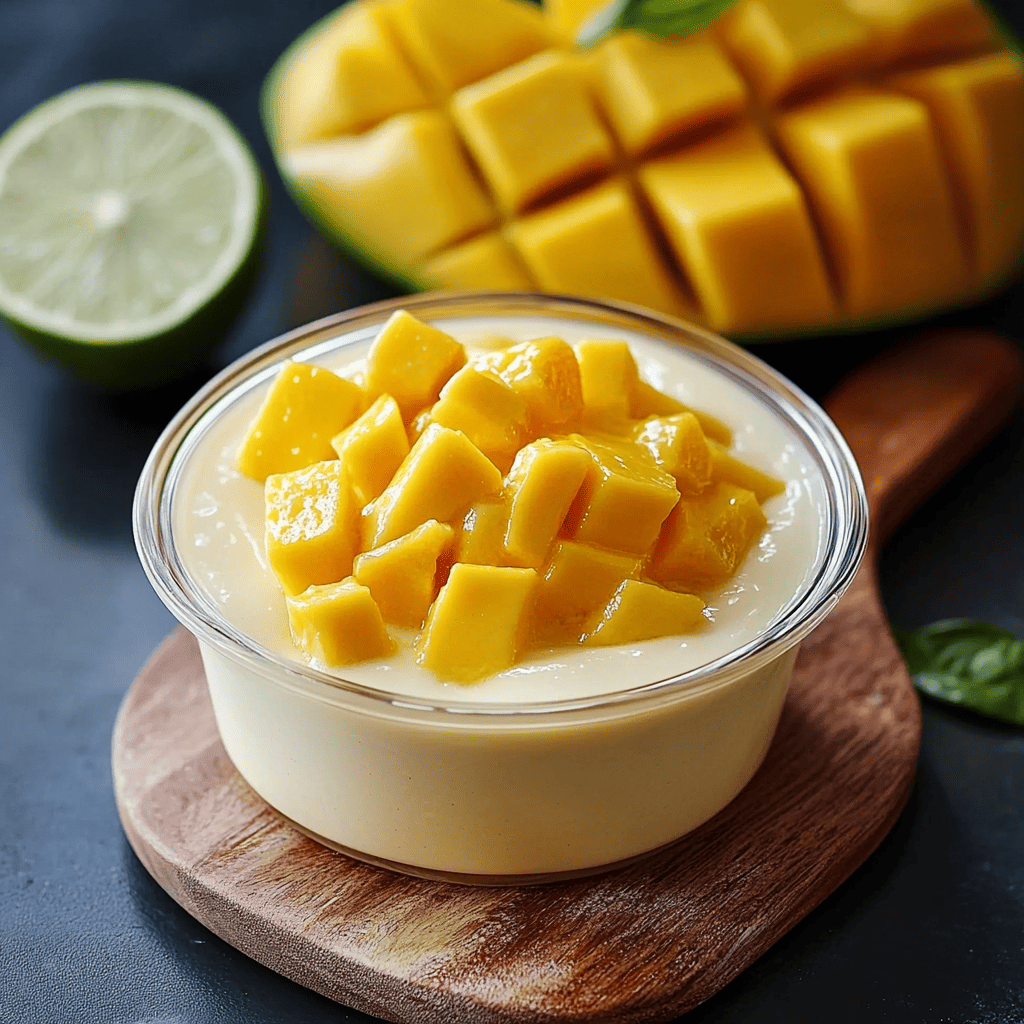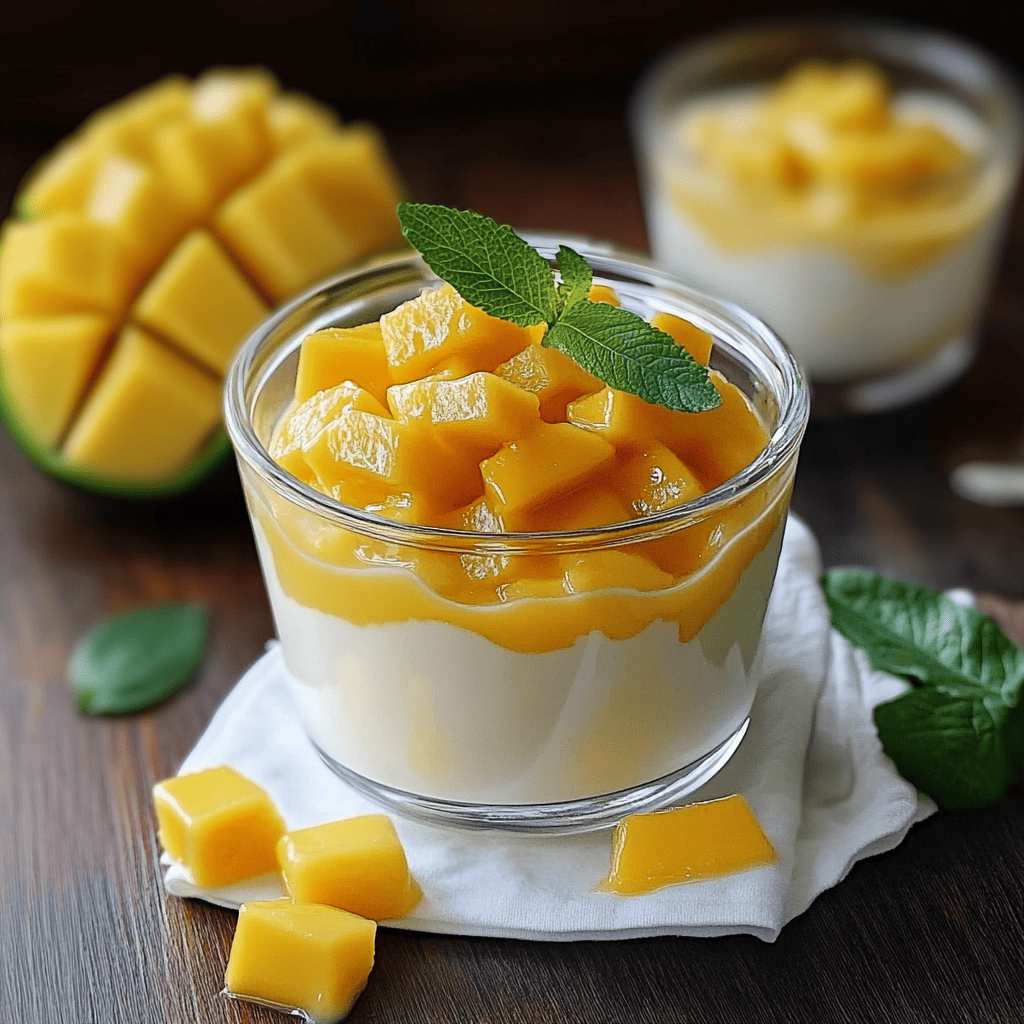Creamy Mango Charlotte with Cheese and Lime: A Tropical Journey of Unforgettable Flavor
Introduction
Welcome to a culinary journey where the exotic sweetness of mango, the smoothness of cream cheese, and the sparkling acidity of lemon merge into a symphony of flavors and textures: Creamy Mango Charlotte with Cheese and Lemon. This vibrant and delicious dessert has become a favorite in countless homes, especially during mango season, when this tropical fruit reaches its peak flavor and juiciness.
Mango Carlota isn’t just a dessert; it’s a celebration of freshness, an ode to elegant simplicity, and a showcase of how well-chosen ingredients can be transformed into a memorable culinary experience without even turning on the oven. Its relatively simple preparation makes it a perfect choice for both novice and experienced cooks looking for a sweet and refreshing ending to any meal.
In this comprehensive article, we’ll explore every facet of this pastry gem. From its intriguing history and the evolution of the “Carlota” concept, to a detailed breakdown of its ingredients and step-by-step preparation instructions. We’ll also offer expert advice, uncover interesting facts, analyze its flavor profile, its context for consumption, and much more. Prepare to immerse yourself in the world of Mango Carlota and discover why this dessert has won over so many palates.
A Detailed History of Carlota: A European Culinary Legacy with a Mexican Soul
The name “Carlota” evokes images of elegance and sophistication in the world of pastries, and its history is as rich and layered as the dessert itself. To understand Mango Carlota, we must first travel back in time and explore the European origins of this type of dessert.
European Origins: “Charlotte” and Marie-Antoine Carême
The dessert known as “Charlotte” has its roots in 18th or early 19th-century Europe. Originally, it was a cooked fruit pudding, often with bread or sponge cake. One of the earliest versions is “Apple Charlotte,” where buttered bread slices were used to line a mold, which was then filled with stewed and spiced apples and finally baked.
However, the transformation of the Charlotte into the cold, molded version we know today is largely attributed to the legendary French chef Marie-Antoine Carême (1784–1833), known as the “King of Chefs and Chef to Kings.” Carême was instrumental in the codification and refinement of French haute cuisine. In the early 19th century, Carême created the “Charlotte à la Parisienne,” later popularized as “Charlotte Russe.”
Charlotte Russe is a cold dessert that differs significantly from its baked predecessors. It consists of a mold lined with ladyfingers and filled with Bavarian cream (crème bavaroise), a custard thickened with gelatin and enriched with whipped cream. This creation was served cold and was noted for its elegance and delicacy.
It is said that Carême may have named this dessert after Princess Charlotte, daughter of King George IV of Great Britain, for whom she briefly worked. Another theory suggests it could have been named after Tsarina Charlotte of Prussia, wife of Tsar Nicholas I of Russia, as Carême also spent time at the Russian court. Regardless of the exact muse, the name “Charlotte” became associated with these elegant, molded desserts.
Arrival and Adaptation in Mexico: From Carlota de Limón to Carlota de Mango
Cultural and culinary exchanges between Europe and Latin America, especially during the 19th and early 20th centuries, facilitated the arrival of many recipes and culinary techniques to the New World. Mexico, with its own rich culinary tradition, adopted and adapted numerous European preparations, giving them a distinctive local touch.
The idea for “Charlotte Russe” likely reached Mexico and, over time, was transformed using more accessible ingredients in line with the local palate. The most iconic and widespread version in Mexico is the Carlota de Limón (Lemon Charlotte ). This dessert, incredibly popular for its simplicity and refreshing flavor, replaces sponge fingers with the inexpensive and ubiquitous María cookies . The filling was also simplified, using a mixture of condensed milk, evaporated milk, and lemon juice, which curdles thanks to the acidity of the citrus fruit reacting with the milk proteins, without the need for gelatin in many of its more homemade versions.
Carlota de Limón became a mainstay of Mexican home baking: easy to prepare, economical, and perfect for the warm climate. Its success lay in the brilliant combination of sweetness (condensed milk), creaminess (evaporated milk), and vibrant acidity (lemon juice), all on a biscuit base that softens slightly as it absorbs the moisture from the cream, creating a soft and pleasant texture.
The Evolution of Mango Charlotte: Celebrating Tropical Abundance
With Carlota de Limón firmly established in the Mexican culinary repertoire, the door was open for experimentation with other fruits. Mexico is a country blessed with an enormous diversity of tropical fruits, and the mango is undoubtedly one of the most beloved and abundant.
The Mango Carlota emerges as a natural evolution, applying the same basic concept as the Lemon Carlota—layers of Maria cookies and a fruity cream—but replacing the lemon juice (or complementing it) with the sweet and aromatic pulp of the mango. The addition of cream cheese, as in the recipe at hand, is a touch that further elevates the dessert, providing greater richness, creaminess, and a subtle salty counterpoint that balances the sweetness of the mango and condensed milk.
Mango, with its intensely tropical flavor profile, vibrant color, and fleshy texture, lends itself wonderfully to this type of dessert. The Mango Carlota thus becomes a celebration of this fruit’s season, a dessert that encapsulates the essence of the tropics.
More Details on History and Context
- Icebox Cake Influence : The Carlota, in its no-bake versions, shares similarities with the Anglo-Saxon tradition of icebox cakes, which became popular in the United States in the 1920s and 1930s with the proliferation of electric refrigerators. These cakes are also characterized by the use of biscuits or sponge cakes that soften upon contact with a creamy filling and are served cold.
- The Role of Canned Milk : Gail Borden’s invention of condensed milk in 1856 and the subsequent availability of evaporated milk revolutionized baking, especially in regions where fresh milk wasn’t always accessible or safe. These products became essential ingredients in many Latin American desserts, providing sweetness, creaminess, and a long shelf life. La Carlota is a clear example of their use.
- Maria biscuits : These biscuits, originally from England (Marie biscuits, created in 1874 by Peek Freans in London to commemorate the marriage of Grand Duchess Maria Alexandrovna of Russia to the Duke of Edinburgh), have become a staple in many countries, including Spain, Portugal, and much of Latin America. Their neutral flavor and texture make them ideal for desserts like carlotas, as they absorb liquids well and complement a wide range of flavors.
- The Mango in Mexican Culture : The mango isn’t just a fruit in Mexico; it’s a cultural icon. It’s eaten fresh, in fresh juices, ice creams, hot sauces, candied sweets, and, of course, in desserts. Mango season is eagerly awaited, and its abundance translates into an explosion of culinary creativity. The Carlota Mango is a reflection of this appreciation for the national fruit. Varieties such as the Manila, Ataulfo, Kent, Keitt, and Tommy Atkins mangos are common, and each contributes slightly different nuances to the dessert.
In short, Creamy Mango Carlota with Cheese and Lime is the result of a fascinating culinary evolution: from elegant European salons to Mexican home kitchens, adapting, transforming, and enriching itself with the flavors and bounty of the land. It’s a dessert with history, but above all, with a flavor that conquers the present.

Ingredients
- 1 kg ripe, juicy mango: Look for mangoes that are fragrant, yield slightly to pressure, and have no dark spots or bruises. Varieties such as Ataulfo, Manila, Kent, or Haden are excellent for their sweetness and low fiber content.
- 1 can of condensed milk (395 g): Provides the main sweetness and a characteristic creamy texture.
- 1 can of evaporated milk (360 ml): Contributes to the creaminess and body of the mixture, with a concentrated dairy flavor.
- 190g cream cheese at room temperature: It’s crucial that it’s soft so it blends perfectly without lumps. Choose a Philadelphia-style cream cheese for the best texture and flavor.
- 1/2 cup freshly squeezed lemon juice: Always fresh! Lemon juice not only provides a delicious acidic counterpoint that balances the sweetness, but it also helps thicken the cream slightly. Adjust the amount to your liking.
- ½ tsp vanilla extract: A subtle touch that enhances the other flavors and adds aromatic depth.
- 2 packages of Maria cookies: The traditional base for this dessert. One package usually weighs between 140g and 170g, so 300-340g in total will be enough, depending on the size of your pan.
To decorate (optional, but recommended):
- Additional chunks of fresh mango.
- Mint or spearmint leaves for a touch of color and freshness.
- Lemon zest to intensify the citrus aroma.
Detailed Preparation
Preparing Mango Carlota is a rewarding and simple process. Follow these steps to ensure a spectacular result:
Step 1: Prepare the Mangoes
- Wash and Peel: Wash the mangoes thoroughly under cold running water. Using a sharp knife or peeler, remove the skin from all of the mangoes.
- Cut the Flesh: Cut the flesh out of the mangoes around the pit. Try to get the most out of the fruit.
- Reserve for Garnish (Optional): From the total pulp, reserve about a cup of diced mango. This will be used to garnish the charlotte at the end and can also be added between the layers if desired.
- Puree the Remains: Place the remaining mango pulp (approximately 750-800g, depending on the size of the pits and the amount reserved) in the bowl of a blender or food processor. Blend until smooth. If your mangoes are very fibrous, you can strain the puree through a fine-mesh sieve to remove any strands.
Step 2: Prepare the Mango and Cheese Cream
- Soften the Cream Cheese: Make sure the cream cheese is at room temperature. If it’s cold, you can cut it into cubes and let it sit for 20-30 minutes, or microwave it for a few seconds on low power (being careful not to melt it).
- Blend the Wet Ingredients: To the blender cup containing the mango puree, add the condensed milk, evaporated milk, softened cream cheese, freshly squeezed lemon juice, and vanilla extract.
- Blend to Perfection: Blend all ingredients at medium-high speed for 2-3 minutes, or until the mixture is completely smooth, creamy, and even. There should be no lumps of cream cheese left. Stop the blender midway through if necessary to scrape down the sides with a spatula and ensure everything is well incorporated. Taste the mixture; if you prefer a more acidic flavor, you can add a little more lemon juice. If your mangoes weren’t very sweet, you’ll rarely need more sugar thanks to the condensed milk, but adjust if absolutely necessary (although this is rare).
Step 3: Assemble the Carlota
- Choosing the Mold: You’ll need a baking dish or a glass, ceramic, or even a springform pan. A common size is approximately 20×20 cm or 20×30 cm if rectangular, or a round pan about 22-24 cm in diameter. You can also make individual servings in glasses or cups.
- First Layer of Cookies: Place an even layer of Maria cookies on the bottom of the pan. Try to cover the entire surface, breaking up some cookies if necessary to fill in the gaps. It’s not necessary to pre-soak the cookies, as they will absorb the moisture from the cream.
- First Cream Layer: Pour a portion of the mango and cheese spread over the cookie layer, spreading it evenly with a spatula or the back of a spoon. The cream layer should be generous enough to cover the cookies well.
- Alternate Layers: Continue alternating layers of Maria cookies and mango cream. Try to make at least 3-4 layers of cookies, or until you run out of ingredients. The last layer should be cream.
- Optional – Mango between layers: If you like, you can sprinkle some of the reserved mango cubes over one of the cream layers before adding the next layer of cookies. This will add texture and more mango flavor to the inside.
Step 4: Decorate and Refrigerate
- Final Garnish: Once you’ve finished the last layer of cream, decorate the surface. Scatter the reserved mango cubes attractively. You can add a few fresh mint or spearmint leaves for a color contrast and a fresh aroma. A little lemon zest also works well.
- Cover and Refrigerate: Cover the mold with plastic wrap (without letting it touch the surface of the custard, if possible) or with a lid if your baking dish has one. Refrigerate the charlotte.
- CRUCIAL Chilling Time: This dessert needs time for the cookies to soften and the cream to firm up. Refrigerate for a minimum of 4 to 6 hours. For best results, chill overnight (8-12 hours). This allows the flavors to blend and the texture to be perfect.
Step 5: Serve
- Cut and Serve: Once the charlotte is completely cool and firm, remove it from the refrigerator. If you used a springform pan, carefully remove the ring. If it’s ovenproof, you can cut portions directly from the pan with a clean spatula.
- Enjoy: Serve immediately and enjoy this tropical delicacy.
Estimated Preparation Time
- Active Preparation Time: 25-35 minutes (includes peeling and cutting mangoes, blending and assembling).
- Cooling Time (Passive): Minimum 4-6 hours, ideally 8-12 hours or overnight.
- Total Time: Approximately 4.5 to 12.5 hours, depending on the cooling time chosen.
Additional Tips for a Perfect Charlotte
- Mango Selection: The quality of your mangoes is paramount. Use ripe, sweet, and low-fiber mangoes. Ataulfo mangoes are an excellent choice in Mexico for their creamy texture and sweetness. If you only find mangoes that are slightly tart, you may need to slightly adjust the amount of condensed milk or be more conservative with the lemon juice.
- Fresh Lemon Juice: Don’t use bottled lemon juice. The flavor of freshly squeezed juice is incomparable and essential to the dessert’s balance. The amount of lemon juice can be adjusted: if you like it more acidic, add a little more; if you prefer the sweetness of the mango to dominate, reduce the amount slightly.
- Soft Cream Cheese: Again, the cream cheese should be at room temperature. This is key to avoiding lumps and achieving a perfectly smooth, silky cream.
- Cream Consistency: The cream should be thick but pourable. If your mangoes are exceptionally juicy, the cream may be a little thinner. Don’t worry too much, as it will thicken considerably in the refrigerator thanks to the effect of the lemon and the cold.
- Thin or Thick Layers: You can decide the thickness of your cookie and cream layers. Some people prefer thinner layers for better integration, while others prefer more defined layers.
- Cookie Variations: Although Maria cookies are the traditional ones, you could experiment with other neutral-flavored cookies if you can’t find them. Digestive biscuits or even sponge fingers (returning to the Charlotte Russe idea) could work, although they would change the classic dessert’s flavor.
- Individual Molds: Preparing the charlotte in individual glasses or cups is a great idea for more elegant presentations or to control portions. The assembly process is the same.
- Crunchy Touch: If you want to add a textural contrast, you can sprinkle some toasted flaked almonds, toasted shredded coconut, or even granola just before serving.
- Lighter Option (with reservations): You could try using light cream cheese and lighter versions of the milks, but keep in mind that the texture and richness of the dessert will be affected. La Carlota is a naturally indulgent dessert.
- Storage: Store leftover Mango Carlota, tightly covered, in the refrigerator. It will keep well for 2-3 days. After this time, the cookies may become too soft.
- Freezing (Not ideal for traditional texture): Although it could technically be frozen, the texture of the custard may change upon thawing, becoming slightly more watery or grainy due to the cream cheese and milks. It’s best enjoyed fresh. If you freeze it, it will be more like ice cream or ice cream cake.

Texture and Flavor
- Texture: The Creamy Mango Carlota with Cheese and Lemon is a symphony of textures. The cream is the main element: incredibly smooth, silky, velvety, and creamy thanks to the combination of mango puree, milk, and cream cheese. After hours of refrigeration, the Maria cookies soften to a soft, almost sponge-like consistency that melts in the mouth. Adding chunks of fresh mango to the decoration or between the layers provides a juicy and slightly firm contrast. It’s a dessert that doesn’t require much chewing, but rather glides down pleasantly.
- Flavor: The flavor profile is a balanced tropical explosion.
- Sweet: The natural and fragrant sweetness of ripe mango predominates, enhanced by condensed milk.
- Acid: Freshly squeezed lemon juice cuts through the richness and sweetness, providing a vibrant, refreshing citrus note that cleanses the palate and prevents the dessert from becoming cloying.
- Creamy and Dairy: Evaporated milk and cream cheese provide a rich, dairy background and subtle complexity. The cream cheese, in particular, introduces a welcome, light salty note that deepens the other flavors.
- Fruity: The mango flavor is the undisputed star, with its characteristic tropical notes that can vary slightly depending on the variety of mango used (from hints of peach and pineapple to floral nuances).
- Subtle Vanilla: Vanilla extract, although in small amounts, rounds out the whole, adding a warm and familiar aroma.
- Neutral Base: Maria cookies provide a very subtle, almost neutral flavor base, allowing the flavors of the cream to shine fully.
Overall, it’s a predominantly sweet dessert, but well balanced by the acidity, with an intense mango flavor that’s addictive and deeply satisfying. It’s refreshing and, despite its creaminess, doesn’t feel overly heavy if eaten in appropriate portions.
Consumer Context
Creamy Mango Charlotte with Cheese and Lemon is a versatile dessert that can be enjoyed in a wide variety of settings:
- Family Dessert: It’s a classic for weekend family meals or as a sweet treat after dinner. Its easy preparation makes it accessible for the whole family to enjoy.
- Celebrations and Parties: Its attractive presentation and delicious flavor make it a welcome guest at birthdays, gatherings with friends, and special celebrations, especially during spring and summer.
- Mango Season: Consumption naturally increases during mango season, when the fruit is at its peak in terms of flavor and price. It’s a wonderful way to take advantage of the fruit’s abundance.
- Warm Climates: Being a cold, no-bake dessert, it is especially popular in warm climates or during the hottest months of the year, as it offers a refreshing relief.
- Dessert to Go: It’s relatively easy to transport (well refrigerated) to picnics, potlucks, or gatherings, as long as it stays cold.
- Light Alternative (in perception): Although it contains caloric ingredients, its freshness and fruity flavor often make it perceived as a “lighter” option compared to cakes baked with heavy frostings, especially if the portion size is controlled.
It’s a dessert that evokes joy, freshness, and the bounty of tropical nature. It’s shared with gusto and rarely disappoints.
Visual Aspect
The Mango Carlota is a visually very attractive dessert, which invites you to taste it:
- Vibrant Color: The dominant color is a beautiful, intense orange-yellow, derived from mango puree. This color is bright, cheerful, and evokes the warmth of the tropics.
- Layers (Optionally Visible): If served in a clear glass container or if you cut a portion from an opaque mold, you can see the distinct layers: the paler lines of the Maria cookies alternating with the thick, colorful layers of the mango cream. This layering is part of its classic charm.
- Smooth, Glossy Surface: The top layer of mango cream typically has a smooth, slightly glossy finish.
- Attractive Decoration:
- Fresh Mango Chunks: Fresh mango cubes on top add visual texture, an even deeper color, and the promise of pure mango flavor.
- Mint Leaves: The vibrant green of mint leaves creates a spectacular color contrast with the yellow-orange of the mango, adding a touch of elegance and freshness.
- Lemon Zest: Small green or yellow dots of lemon zest can adorn the surface, suggesting the citrus note within.
- Presentation: Whether served in a large family dish or in elegant individual glasses, Mango Carlota always looks appetizing. In individual servings, the presentation can be even more elaborate, allowing the layers to be better appreciated from the outside.
Overall, its appearance is sunny, appetizing, and promises a refreshing and sweet experience. It’s the kind of dessert that brightens any table.
Curiosities
- The Name “Carlota”: As we mentioned in the story, the name “Charlotte” or “Carlota” has royal connotations, linked to figures of European royalty. It’s curious how such an aristocratic name has come to refer to such popular and affordable desserts in places like Mexico.
- Lemon Magic: In versions that don’t use cream cheese or that seek extra firmness without gelatin (like the more traditional Lemon Charlotte), the acidity of the lemon juice plays a crucial role by reacting with the proteins in the condensed and evaporated milk, causing the mixture to thicken and set upon cooling. It’s a simple but effective acid-base reaction.
- No Oven Required: One of the great advantages of Carlota is that it’s a no-bake dessert. This makes it ideal for warm climates, for cooks who don’t have an oven, or simply when you want to avoid the heat of an oven.
- Global Adaptability: Desserts similar to Charlotte, which combine cookies or sponge cake with fruit or dairy creams and are served cold, exist in many cultures under different names (e.g., “icebox cake” in the U.S., “tiramisu” in Italy, with its obvious differences, or “pavé” in Brazil). This demonstrates the universality of the concept.
- The Versatility of the Mango: Mango is one of the most consumed fruits in the world, and there are hundreds of varieties. Each one can add a distinct flavor to the Charlotte. In India, for example, the mango is the king of fruits and is used in countless desserts, some of which share conceptual similarities with cold creams.
- Influence of Advertising: In many countries, the popularization of desserts like Carlota has been driven by the condensed milk or cookie brands themselves, which included recipes on their packaging or in advertising campaigns, facilitating their widespread adoption.
- Cream Cheese as an “Upgrade”: The addition of cream cheese to the traditional fruit Carlota recipe (which often only calls for milk and fruit) is seen as an improvement that adds sophistication, a richer texture, and a more complex flavor, bringing it closer to a no-bake “cheesecake.”
Nutritional Value (Estimated per Serving)
It’s important to remember that nutritional values are approximate and can vary significantly depending on serving size, specific brands of ingredients used, and recipe variations. The following estimate is based on a moderate serving (approximately 1/10 to 1/12 of the total recipe, or 150-180g).
Estimate per serving (approx. 150-180g):
- Calories: 350 – 450 kcal
- Carbohydrates: 50 – 70 g
- Of which sugars: 35 – 50 g (from condensed milk, mango and cookies)
- Fats: 15 – 25 g
- Of which saturates: 8 – 15 g (mainly from cream cheese and milk)
- Protein: 5 – 8 g
- Fiber: 1 – 3 g (mainly from the mango and some from the cookies)
- Sodium: 150 – 250 mg
Nutritional Considerations:
- Energy Source: It is an energy-dense dessert, mainly due to carbohydrates (sugars) and fats.
- Vitamins and Minerals:
- Mango: Provides vitamin C, vitamin A (in the form of beta-carotene), and folate.
- Dairy: Condensed milk, evaporated milk, and cream cheese provide calcium and vitamin D (if fortified), but also saturated fats.
- Lemon: Source of vitamin C.
- Moderation is Key: Like any indulgent dessert, Mango Charlotte should be enjoyed in moderation as part of a balanced diet. Its high sugar and fat content makes it more of an occasional treat than a daily staple.
- Lighter Alternatives: If you’re looking to reduce the calorie content, you could experiment with low-fat cream cheese and low-fat evaporated milk, and slightly reduce the amount of condensed milk (offsetting the sweetness with very sweet mangoes). However, this will affect the texture and richness of the dessert.
It is a dessert to fully enjoy the flavor, being aware of its nutritional contribution.
Additional Benefits and Interesting Facts
Beyond its exquisite flavor, we can highlight some benefits and interesting facts associated with its ingredients and concept:
Potential Benefits of Ingredients:
- Mango:
- Rich in Antioxidants: Mangoes contain compounds such as mangiferin, quercetin, and various catechins, which have antioxidant properties and help combat oxidative stress.
- Immunity Support: Its high content of vitamin C and vitamin A is crucial for the proper functioning of the immune system.
- Digestive Health: Mangoes contain dietary fiber and some digestive enzymes (such as amylases) that can aid digestion.
- Eye Health: Vitamin A and antioxidants like lutein and zeaxanthin present in mango are beneficial for eye health.
- Lemon:
- Vitamin C: A powerful antioxidant that supports the immune system and collagen production.
- Alkalizing (despite being acidic): Although it is acidic, lemon is said to have an alkalizing effect on the body once metabolized.
- Traditional Digestive Aid: Often taken to stimulate digestion and relieve mild indigestion.
- Cream Cheese and Dairy:
- Calcium and Protein: They contribute to the supply of calcium for bone health and proteins for tissue construction and repair.
Additional Interesting Facts:
- Emotional Comfort Food: For many, Carlota (in any version) is a “comfort food,” a dessert that evokes memories of childhood, family celebrations, and happy moments. Preparing and sharing it can have a positive effect on your mood.
- Ease and Accessibility: The fact that it doesn’t require complex baking skills or hard-to-find ingredients makes it very democratic and accessible for almost anyone who wants to venture into baking.
- Celebrating Seasonality: Using mangoes in season not only guarantees better flavor and price, but also connects us with nature’s cycles and promotes the consumption of local products.
- The Art of Simplicity: Mango Carlota is a testament to how simple ingredients, when cleverly combined, can result in something extraordinarily delicious. Complicated techniques aren’t always necessary to create magic in the kitchen.
- Creative Potential: Although this recipe is specific, the base of the Carlota invites creativity. You can use different fruits, spices (a touch of cardamom or ginger with the mango would be interesting), or even add liqueurs to the cream for a more adult version.
Other Relevant Information
- Choosing the Mango Variety: As mentioned, the mango variety will influence the flavor. Ataulfo, Manila, Kent, or Haden mangoes are typically sweet and less fibrous. If you use a more acidic or fibrous variety, adjust the sweetness and consider straining the puree.
- Ripening Mangoes: If you buy mangoes that are still a little green, you can let them ripen at room temperature. To speed up the process, place them in a paper bag (optionally with an apple or banana, which release ethylene gas).
- Sensitivity to Extreme Cold: Do not freeze whole mangoes for later pureeing, as the texture may change. It’s best to use fresh mangoes or good-quality frozen mango flesh.
- Common Problems and Solutions:
- Cream Too Liquid: This can be due to overly juicy mangoes or too little lemon juice. Make sure the cream cheese is well incorporated. Refrigerating for a long time usually fixes this problem. If it persists, for future use, you can slightly reduce the amount of evaporated milk or add a little more cream cheese or a pinch of unflavored gelatin (hydrated and dissolved) to the mixture if you’re looking for a more mousse-like firmness (although this alters the traditional recipe).
- Lumps in Cream: Usually caused by cold cream cheese. Make sure it’s at room temperature and blend well.
- Charlotte Doesn’t Set Enough: Check the amount of lemon juice and the refrigeration time. Patience is key.
- Serving and Cutting: To cut clean portions, dip a sharp knife in hot water and dry it before each cut. Wipe the knife clean between cuts.
- Suggested Pairings:
- Drinks: A mild coffee, herbal tea (such as chamomile or mint), or even a fruity, sparkling white wine (such as Moscato d’Asti) can complement this dessert well. A glass of fresh water or hibiscus water is also a great option.
- Other Toppings: While delicious on its own, a small scoop of coconut or vanilla ice cream could take it to another level of indulgence.

Conclusion: A Refreshing Classic That Makes You Fall in Love
Creamy Mango Carlota with Cheese and Lime is much more than a simple dessert; it’s a sensorial experience that captures the essence of the tropics in every spoonful. Its perfect balance of lush mango sweetness, rich creaminess of cheese and milk, and the invigorating touch of lemon make it an irresistible choice for any occasion.
From its humble origins as an ingenious adaptation of a European classic to becoming a star of homemade and festive baking, the Carlota has proven its ability to evolve and delight generations. The version with mango and cream cheese is undoubtedly one of its most sublime interpretations, offering a seductive texture and a flavor that lingers on the palate and in the memory.
Easy to prepare, visually stunning, and universally beloved, we strongly encourage you to venture out and create your own Mango Carlota. Whether to share with family, surprise friends, or simply treat yourself, this dessert promises to transport you to a paradise of refreshing flavor and joy. Enjoy this creamy wonder!

